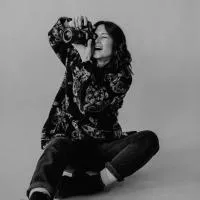Contents
Should you make the jump and move to a new TLD (like a .photography domain) instead of the old-faithful “.com”? Probably not yet, but it’s still useful to get those new domains for “brand protection”.
Let’s go through everything you need to know about the new photography top-level domains: problems, examples, resources and a Q&A section.
What are TLDs?
The best practices, when you’re choosing a domain name for your photography business, is to try to keep it short and simple. But .com and other old TLDs (.net, .org etc.) are limited resources and are becoming way too crowded for this digital age.
The authority governing over domain names has released new TLDs to try to solve the problem and diversify the domain landscape.
It is common for photographers to try to include their profession or field of work in the domain name (johndoephotography.com or johndoeweddings.com), but they can now simplify that with a new domain like johndoe.photography (that’s it, notice it’s not johndoe.photography.com, no more .com)

New TLDs for photographers & other creative professionals
- .photography
- .photos
- .photo
- .pics
- .pictures
- .camera
- .gallery
- .graphics
- .lighting
- .equipment
- .travel
- .weddings
From what I’ve seen, the .photography and .photo domains are the most popular among photographers that made the switch.
The problems with new photography TLDs
1. Market adoption & awareness
A domain name should generally adhere to three main principles:
- should be short (for easier social sharing)
- should include keywords if possible
- should be easy to remember and share
In my opinion, new photo TLDs help with the first two. But for the time being, they negatively affect the third one: people are not yet used to remembering & typing non-traditional domain names. Non tech savvy users might still get confused and try to append “.com” to the end of the domain when typing it in.
In time, blog posts like this one will raise awareness over new TLDs and people will grow more accustomed to them, eventually lifting this problem.
But for the time being, from a user point of view, new TLDs still have a long way to go before mass adoption.
2. Smaller SEO value
Most likely, the new TLDs will have less SEO weight than their .com counterparts. Only Google knows how large the gap really is (if any).
But in the short term, don’t expect a huge SEO boost from getting a new-TLD name, quite the opposite.
3. Browser & software compatibility
Any TLDs that are longer than 3 characters usually run into compatibility issues in various browsers or apps. Developers and infrastructure providers still need to work on “integrating” new TLDs into their work, to allow for a smoother adoption.
This is especially important for sites/apps which convert URLs into links automatically (like Twitter or mail apps do). They’re now all starting to support new TLDs, but it’s a work in progress.
Proof of this, Michael Chadwick (a pro photographer which migrated his site to chadwick.photography) says: “Some sites I advertise on don’t accept the email address in their validation process so I still have to keep an old email address on file and in use with them.”
Examples
Despite any problems, many photographers have already fully migrated their site to a .photography domain. You can browse some of these sites by doing a site:.photography search on Google.
Here’s a website which had good results with the new domain: Jon Harris Photography
Jon said he saw a 57% increase in visitors (comparing averages over 3 month periods before and after the switch). While there are surely many factors in a change in web traffic, it surely didn’t hurt.
Michael Chadwick, on the other hand, mentioned that the “only impact has been some confusion from people on believing there is no .com at the end and saying the site doesn’t work.“

Example of another photographer making the switch to .photography:
FAQ
1. Where can I purchase new domains from?
One of the best ways to get new domains (and usually cheaper and with better support than GoDaddy) is NameCheap.com
2. Are there any discounts for new domains?
Most domain registration providers to have discounts in place to help with the adoption of new TLDs. For NameCheap, you can look here https://www.namecheap.com/promos/coupons/
But generally you can simply Google for “registrar discount codes” or “registrar promo codes” for your preferred domain registrar.
3. Should I get .photography or .photos or .pictures?
If you are keen on getting a new TLD for your site (instead of the old-faithful .com), I’d go with .photography in most cases. It’s a trade-off between being shorter and sounding more professional.
4. Where can I get a list of all recently launched TLDs?
http://newgtlds.icann.org/en/program-status/delegated-strings
5. How do I know which TLDs will be launched in the future?
https://www.namecheap.com/domains/new-tlds/explore.aspx
6. If I type a new-generation domain into a browser, I get a Google search instead. What’s up with that?
Some browsers still don’t fully support new TLDs yet, so they don’t recognize them. It’s just a matter of time before browsers will fix this issue, there’s nothing you can do at this time.
7. People are still confused by new TLDs (and are appending .com when typing). Why put them through this?
Change comes with such initial problems, but it’s all for the better. Users will adapt, it just takes some time.
In the meantime, you can help them by properly redirecting your domains (johndoephotography.com to johndoe.photography, depending on your set-up).
8. What about Location TLDs?
New geographic TLDs like .london or .nyc might be useful if you have really specific local services. But you have to make sure you’re not limiting your brand’s future.
9. What if I’m based in the UK? Should I get rid of my .co.uk domain?
No, consider switching to just .uk
10. More stuff to buy???
Your concern is understandable, these new TLDs bring little usability to users, and a lot of income for ICANN. But if you want to protect your online identity, you have to put in the (financial) effort.
11. I’m still confused, and skeptical about the new TLDs. What should I do?
When in doubt, definitely stick to your existing domain (if it’s good).
12. We’re an agency and/or have a really strong brand name. What should we do?
Protecting the brand name should be your priority. If you have the budget for it, try getting all relevant domain names (under new TLDs) and redirect them to your existing main site. You don’t want to give any room to impersonators.
13. I’ve now purchased my new domain(s). What now?
You should forward it/them to your existing mail domain for now. How to do this depends on your registrar, but a quick Google search (“registrar forward domain”) usually does the trick.
If you’re instead interested in actually migrating your site to a new domain, you should get in touch with professionals to handle this job. Doing it properly avoids any technical and SEO problems that might affect your site. Shameless plug: ForegroundWeb has a large experience with website migrations and other services, just send a quick message to get a free quote.
14. Is Google surely indexing .photography domains (or other new TLDs)?
Absolutely. Just do a search for site:.photography to see for yourself.
15. Securing many related domains is the best way to protect my brand?
No, you should instead first focus on registering your name as a trademark.
16. Besides my brand name, should I buy other interesting domain names on new TLDs? Something that really stands out?
Don’t even bother, you’ve missed the “gold rush”. You’d just be wasting time and money.
17. What will the future of TLDs be like?
Here’s a great article: http://www.digitaltrends.com/computing/will-new-top-level-domains-change-use-web/#!bhxCDB
18. Does Google favor new TLDs in its search results?
Short answer: no.
Takeaways
The introduction of new TLDs is fairly new, so they might need more time to “mature” before being widely adopted by online communities.
But that doesn’t mean you should secure your own domain on a new TLD (or more). You’re simply making sure that someone else won’t take it first (especially if you have a common name).
- For the time being, I recommend that you stay with your existing domain (whether that’s .com, .co.uk etc.) A new TLD now might hurt your branding.
- Purchase relevant names on new TLDs just for future safety, especially if you already have a strong brand name or trademark. This protects you from “cybersquatting” and prevents legal problems in the future. And if you’re a solo photographer with the word “photography” in the domain name, purchasing your .photography domain would be a way of shortening it too.
- Redirect/forward any new domain to your existing site (for now).
The jury is still out on whether photographers will start taking advantage of these new top level domains.
What are your thoughts on using them? Can you share some results you’ve had?
If you do ever decide to switch to a new domain name, this guide is a must-read:
How to change your site’s domain name (URL) without losing SEO rankings

















